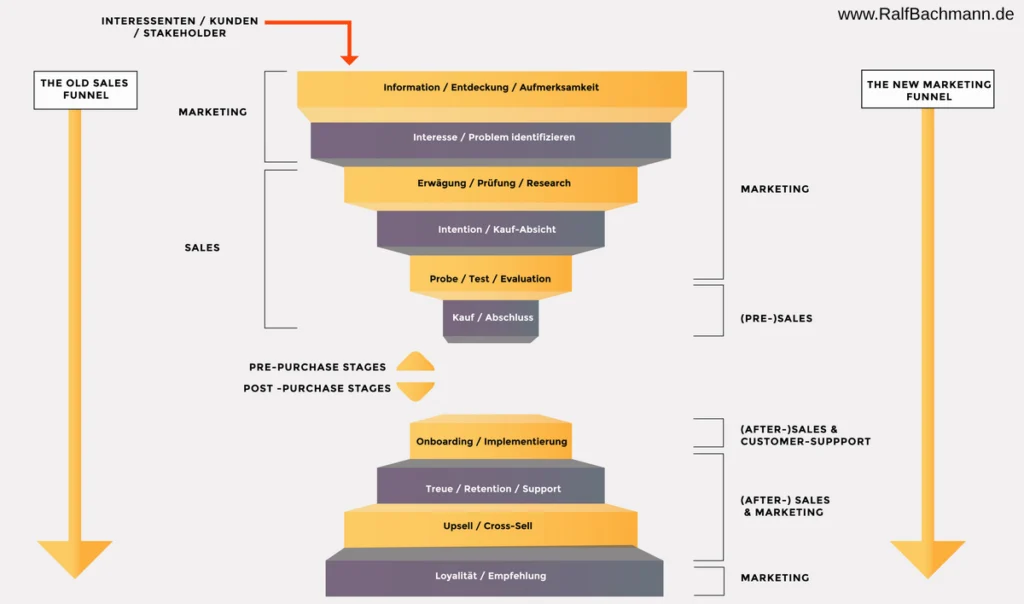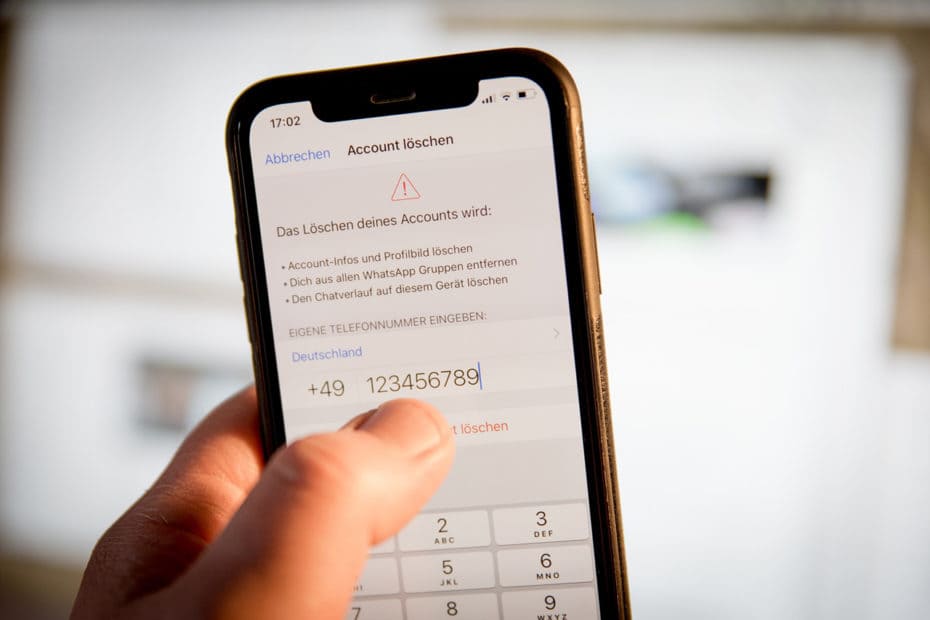Or: Content marketing as the answer to the "new marketing funnel"
The traditional marketing and sales funnel that has existed for decades is changing. Companies and their marketing departments are facing new challenges, as customers’ purchasing and research behavior has changed fundamentally. Marketing and sales must work more closely together to accompany customers throughout the entire customer journey and develop effective strategies. However, this also requires an adaptation to changing customer behavior. Information channels have become more diverse, customer service expectations have risen and the selection criteria for service providers or suppliers have become more extensive.
Awareness of the importance of seamless interaction between marketing and sales (aka marketing and sales alignment) is also growing in German-speaking countries. The days of isolated silos are over – close coordination between the two areas is crucial for sustainable success. Companies that drive this integration forward now will secure a clear competitive advantage.
How can your company achieve optimal integration?
This article will analyze the current changes and outline possible solutions for how companies can optimize their funnel strategies.
Spoiler: The internal upgrading of marketing departments in the company’s internal ranking is also essential.
The changing dynamic between marketing and sales
Times are changing. The Internet – even if it sounds trite – is changing everything. Even the exchange with customers. One click and the customer can find initial information on any topic and any product. Things used to be different. Arian Ruß sums it up well.
[quote in german]
Then came analog marketing and the first digital attempts. Traditionally, the division of roles in the B2B sector between marketing and sales was clearly defined:
- Marketing generated leads and passed them on to sales.
- Sales was responsible for converting leads into paying customers.
This model has led and continues to lead to tensions between the departments.
✅ Sales was dissatisfied with the lead quality and felt solely responsible for the turnover.
✅ Marketing was criticized for not providing enough ready-to-buy leads.
✅ Both departments increasingly focused on quantity rather than quality, which led to inefficiencies and increased frustration on both sides.
✅ In many B2B companies, the role of marketing has been reduced to that of a supplier for sales. Not only leads, but also materials such as white papers, case studies, etc. were ordered by Sales as the leading department, just like in a restaurant. And marketing had to deliver. There was often no trace of strategy and long-term positioning.
However, the traditional boundaries between marketing and sales are becoming increasingly blurred. This is also due to the fact that the purchasing and research behavior of prospective and existing customers has changed significantly – almost emancipated them.
Marketing is therefore becoming increasingly strategically important in the B2B sector. It is crucial to provide information in a targeted manner, at the right time and via the right channels. Many companies – both in sales and marketing – are still not fully aware of this change.
While the responsibility of marketing is continuously growing, sales only comes into play in later phases of the customer process. The classic division along the sales funnel has changed fundamentally – today we speak more accurately of an integrated marketing and sales funnel.
How do companies deal with this shift? What strategies do you use to optimally coordinate marketing and sales?
How purchasing behavior has changed
1 Decentralized decision-making
Companies have adapted their decision-making processes:
- Economic uncertainties have led to purchasing decisions being more decentralized to individual business units.
- Instead of a single decision-maker, there are now consensus-oriented purchasing processes with several participants.
➡ This complicates the sales process, as the sales department has to convince several stakeholders. Or to put it another way, there are many different personas (target groups) in today’s purchasing process that need to be addressed and picked up. A core task of strategic marketing.
2. Independent information procurement
The emancipation of customers & interested parties:
Modern buyers are more informed than ever before. Studies show that 60-70% of the purchase decision (depending on the type of reading and source) has already been made before a conversation with the sales department even takes place.
The reasons for this:
📌 Companies use websites, forums, social media and test versions to obtain comprehensive information in advance. In the worst case, under “cover names” – i.e. anonymously
📌 56% the web search is the most important source of information
📌 65% want relevant content
📌 65% want price/competitive information
📌 55% want to see industry knowledge (case studies)
📌 Purchasing decisions are increasingly based on customer reviews and recommendations.
📌 Traditional cold calls are becoming less effective as buyers prefer to do their own research.
📌 83% of the “contact” with the company is accounted for by the (mostly anonymous) research phase
📌 19% stated that the first step was to speak to a representative of a provider
📌 77.9% of search queries occur in the middle of the funnel, i.e. in the information search phase
📌 90% of all decision-makers google first when making investment decisions
📌 80% of B2B customers use digital channels to research products and services.
📌 90% of customers do not follow a straightforward customer journey, but often repeat at least one or more tasks in the decision-making process
📌 78% of the solutions purchased were already known before the research (brand awareness as a key factor)
➡ Conclusion: Companies must adapt their funnel in order to be present (perhaps even concise) in the search phase. Those who are not visible (and relevant) online will be left out in the future.
The end of the classic AIDA model: focus on the customer journey
The traditional AIDA model (Attention, Interest, Desire, Action) is no longer sufficient to map today’s purchasing process.
Instead, the focus is on the entire customer journey.
How marketing influences the customer journey:
✅ Accompanying the customer through the entire decision-making process – not just up to lead generation
✅ Targeted analysis of customer interests to guide the purchase intention
✅ Use of social proof (customer reviews, testimonials, case studies) to build trust
✅ Serving all touchpoints, which can be between 1 and 50 touchpoints depending on the status and “temperature” of the lead
✅ After-sales support through marketing to retain customers and for up/re-sell
➡ Conclusion: Marketing must act more strategically and promote long-term customer loyalty at all levels of the funnel.
New marketing tools for an optimized customer journey
Digitalization, cloud technologies, AI-supported CRM systems and social media have given marketing new opportunities to strategically support the purchasing process.
Important tools & strategies:
✅ Social media marketing: by targeting potential customers on LinkedIn, Twitter & Co.
✅ Content marketing: providing valuable content (whitepapers, webinars, blogs) for informed purchasing decisions
✅ Marketing automation: use of AI-supported tools for lead nurturing and analysis of customer behavior
✅ Real-time data analysis: monitoring tools provide valuable insights into the behavior of potential buyers
➡ Conclusion: companies that use these strategies can actively shape the decision-making process.
Customer loyalty as a new strategic goal
The funnel no longer ends with the purchase. Companies are increasingly focusing on customer loyalty and brand loyalty to ensure long-term success.
How modern companies retain customers in the long term:
✅ Personalized offers & services after the purchase
✅ Excellent customer service to strengthen the customer relationship
✅ Customer-centric data analysis to better understand behavior and needs
➡ Goal: Customers should not just buy once, but up/re-sell or, ideally, become brand ambassadors. The same applies here:
[quote in german]
The new marketing and sales funnel: What’s changing
The developments described above are leading to a new understanding of the funnel:
✅ Marketing takes over earlier sales tasks:
Customer engagement & support in the early & middle stages of the funnel.
✅ Sales focuses on qualified leads:
Sales has to spend less time on cold calling as customers are already well informed. Conversely, however, this means that sales has to get even closer to the customer. It is not enough to clarify what the customer wants and then prepare a nice offer. The conversation must be different than before. Important questions need to be clarified, implementations demonstrated and a roadmap developed. None of this makes the job any easier. In fact, the challenges are sometimes even greater.
Long-term effects:
📌 Marketers increasingly need sales know-how (“sales DNA”) without slipping too much into puffery. Sales through marketing is a special hybrid that needs to be mastered. Selling without wanting to sell, or at least making it look like it. That is the challenge.
📌 Marketing is gaining strategic importance within corporate management.
📌 Marketing takes the lead and must be structured more strategically.
📌 Marketing must guide sales, not the other way around.
➡ Companies that ignore this development will lose touch with the modern B2B sales process.
Or as Arian Ruß puts it:
[quote in german]
Conclusion: The future of the funnel requires a rethink
Digitalization and changes in purchasing behaviour require marketing and sales to be closely interlinked.
✅ Marketing must be further integrated into the purchasing process and remain active beyond lead generation.
✅ Sales focuses on ready-to-buy, pre-qualified leads in order to close the deal more efficiently.
✅ Companies that proactively shape this change benefit from greater efficiency and sustainable growth.
✅ Industry-leading companies are 69% more likely than all others to align their marketing content with the key stages of the sales process
✅ Companies that clearly communicate the value of their products and services achieve a 20% higher profit margin
Frequently asked questions (FAQs)
The AIDA model takes too linear a view of the purchasing process. In the modern customer journey, customers switch back and forth between different phases and make informed decisions over longer periods of time.
Content marketing is the secret weapon and helps potential customers to orient themselves in the information phase, build trust and make purchasing decisions – before they speak to sales.
5 possible steps for using the content marketing funnel
- Create a separate funnel for each offer.
- Collect and assign customer questions to the funnel phases.
- Check existing content on your website.
- Supplement any missing content with blog posts, e-books, videos or images.
- Define suitable channels for each phase, create a communication plan and set targeted online and offline touchpoints.
Marketing can support sales through targeted lead-nurturing strategies, high-quality content, marketing automation and social proof (e.g. customer reviews).
Marketing automation, CRM systems, AI-supported analysis tools, social media monitoring and content management systems are crucial for an effective funnel strategy.
Long-term customer loyalty ensures recurring sales, strengthens brand perception and leads to valuable recommendations from satisfied customers. It is 6 to 7 times more effective (other sources speak of 5 to 10 times more cost-effective) to build up an existing customer than to find a new customer. (Source 1 // Source 2)
Bonus:
Maël Roth skillfully expresses on LinkedIn how the old “lead mindset” of sales does more harm than good to companies.
It amazes me, how many software companies still hide their product behind a “Get in Touch with Sales”, or “Ask for a Demo”. 😐
As if I need to earn the right to see your product in action.






